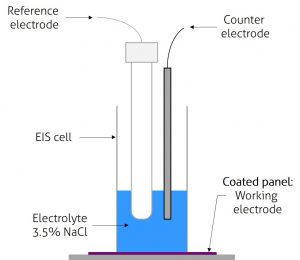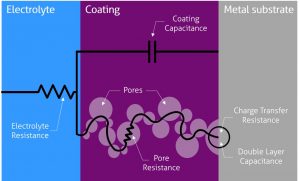Corrosion Testing via Electrochemical Impedance Spectroscopy (EIS)
Fast and reliable determination of barrier performance
- Non-destructive standard or accelerated EIS measurements
- Laboratory technology screening and/or on-site measurements
- Expertise in modelling
- Formulation insights and optimization
How it works
EIS Principle
Electrochemical Impedance Spectroscopy (EIS) is a well-established quantitative method for the accelerated evaluation of the anti-corrosion performance of protective coatings. Within short testing times, EIS measurements provide reliable data, allowing for the prediction of the long-term performance of the coatings. The result of EIS is the impedance of the electrochemical system as a function of frequency.

EIS is a versatile testing procedure, and can be performed under different conditions of stress, depending on the performance of the tested coatings.
Experimental Setup
A measuring cell is placed on the coated panel (working electrode), filled with a 3,5% NaCl solution. A graphite electrode is used as counter electrode, and a standard Ag/AgCl cell as reference electrode. Measurements are carried out over a broad frequency range from 100 kHz to 10 mHz, using a 50 mV amplitude sinusoidal voltage.

Data Interpretation
Impedance spectroscopy data is modelled as an equivalent circuit:

From the equivalent circuit modelling, three significant parameters are obtained: coating resistance, water uptake and corrosion rate.
Our Expertise
VLCI has 5-year experience operating EIS for various industries and applications. We use two different potentiostats:
- one for precision laboratory testing, equipped with a multiplexer that increases our testing capacities eightfold.
- and another portable one equipped with magnetic probes for non-destructive on-site measurements.
We perform different types of EIS measurements:
- Standard EIS (ISO 16773) measures barrier performance and water uptake during immersion, and gives relevant results within three weeks. It can be extended for even longer-term testing.
- Accelerated EIS (ISO 17463) applies electrical stress to promote delamination and speed up corrosion processes. This approach is very useful for barrier performance comparison in only 24 hours.
- Linear Polarization Resistance (LPR) is another quick electrochemical method for measuring corrosion resistance. In LPR experiments, the potential is swept in a small range around the open-circuit potential, and the resulting current of the system is measured.
Read Also
Bunge – Amorphic – Standard EIS
Oops! We could not locate your form.
Applications & Project Examples
- EIS is widely used to evaluate durability of high performance coatings (delamination, corrosion rate, water uptake).
- EIS can also be used to measure barrier performance of any type of films.
- Our EIS device also measures conductivity, and can therefore be used to assess emulsion types (o/w, w/o, miro-emulsion), and phenomena such as phase inversion temperature.
- We use EIS for on-site measurements to determine the performance and integrity of coatings.